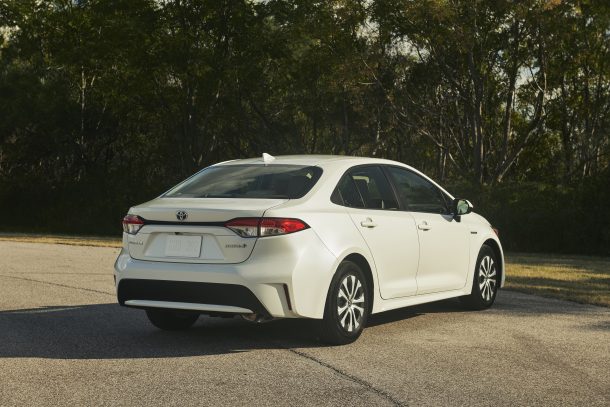Goal Unlocked: Toyota's Non-Prius Delivers the MPGs

It’s Mileage Monday, apparently. In unveiling the upcoming Corolla Hybrid late last year, Toyota predicted the normal-looking alternative to its long-running Prius would deliver a combined rating of 50 mpg, once the EPA got around to testing it.
Not the hardest bar to clear, given that the 2020 Corolla Hybrid uses the same 121-horsepower hybrid powertrain as its stigma-soaked hatch sibling. Toyota stuck the jump with room to spare. There’s also good MPG news for those who hate hybrids but loath the current generation’s tepid four-banger.
Late last week, fuel economy figures poured forth from the Environmental Protection Agency. It turns out the sedate green sedan will indeed top that magic marker, with the 1.8-liter Atkinson-cycle four-cylinder/dual electric motor/CVT trio conspiring to earn the car a combined rating of 52 mpg. City fuel consumption comes in at 53 mpg; highway, 52 mpg.
This is the same combined economy as the stock Prius, though the mileage king Prius Eco tops both by 4 mpg on the combined cycle. Just for comparison, the all-wheel drive Prius (Prius AWD-e) — a new addition for 2019 — earns a 50 mpg combined rating.
No longer do image-conscious Toyota diehards have to sit on the fence, mulling the social repercussions of buying a green commuter from their preferred brand.
As the EPA dispensed info on the entire 2020 Corolla line, there’s more MPG news to share. The next-gen sedan, which borrows the TNGA architecture already in use by the 2019 Corolla hatch, returns 33 mpg combined in base 1.8-liter form, regardless of transmission choice (there’s still a six-speed manual in the lineup, plus the vastly more common CVT). The XSE version of this variant sees a combined figure of 32 mpg.
New to the sedan for 2020 is an engine that won’t leave owners nodding off at the stoplight. In this application, Toyota’s 2.0-liter Dynamic Force four-cylinder returns 34 mpg combined when equipped with the new CVT and 40 mpg on the highway. The tranny incorporates a physical launch gear and 10 ratios available via flappy paddles. Opt for the six-speed stick and combined economy falls to a perfectly acceptable 32 mpg.
Interestingly, a 2.0-liter XSE model outfitted with the CVT returns 34 mpg combined, compared to the 1.8-liter XSE’s 32 mpg. The choice here is clear.
[Images: Toyota]

More by Steph Willems
Latest Car Reviews
Read moreLatest Product Reviews
Read moreRecent Comments
- MRF 95 T-Bird I recently saw, in Florida no less an SSR parked in someone’s driveway next to a Cadillac XLR. All that was needed to complete the Lutz era retractable roof trifecta was a Pontiac G6 retractable. I’ve had a soft spot for these an other retro styled vehicles of the era but did Lutz really have to drop the Camaro and Firebird for the SSR halo vehicle?
- VoGhost I suspect that the people criticizing FSD drive an "ecosport".
- 28-Cars-Later Lame.
- Daniel J Might be the cheapest way to get the max power train. Toyota either has a low power low budget hybrid or Uber expensive version. Nothing in-between.
- Daniel J Only thing outrageous was 400 dollars for plug replacement at 40k miles on both our Mazdas with the 2.5T. Oil change every 5K miles.



































Comments
Join the conversation
Speaking of the Prius, I finally figured out what the rear of the car reminded me of. I finally figured it out. The Silver Hornet: youtu.be/0z-FtAMg6Vw
It's pretty obvious that Toyota will transition the Prius nameplate - which is worth a ton to non-enthusiasts - to their EV platform, whenever that comes online. I suspect the next Prius will be EV only.